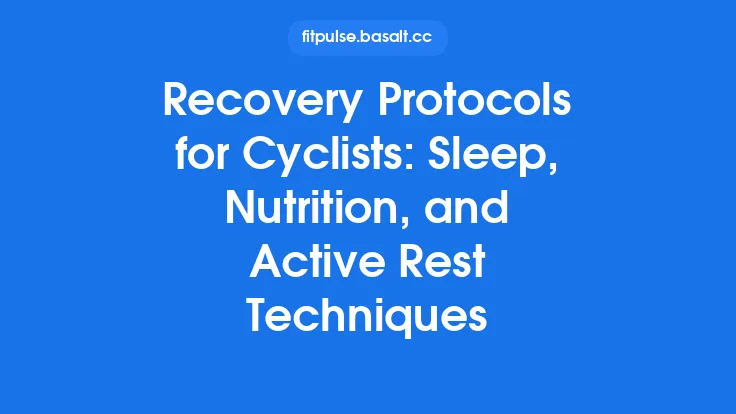Active Isolated Stretching (AIS) has become a staple in the toolbox of athletes, clinicians, and anyone seeking to move more freely. Unlike traditional static or ballistic stretching, AIS emphasizes brief, controlled contractions followed by a quick release, allowing the muscle to lengthen without triggering the protective stretch reflex. This approach creates a unique blend of neuromuscular activation and connective‑tissue pliability, delivering a range of functional advantages that extend far beyond the gym floor.
Fundamental Principles of Active Isolated Stretching
- Brief, Repeated Holds
AIS stretches are held for only 2–5 seconds before the limb is returned to the starting position. The short duration prevents the muscle spindle from initiating a reflexive contraction that would otherwise limit the stretch.
- Active Contraction of the Opposing Muscle Group
While the target muscle is being stretched, the antagonist muscle is deliberately contracted. This “reciprocal inhibition” signal tells the nervous system that the joint is safe to move further, allowing a greater range of motion with less discomfort.
- Progressive, Incremental Lengthening
Each repetition adds a small amount of additional stretch, typically 1–2 degrees of joint angle. Over a series of 8–10 repetitions, the cumulative effect can be a noticeable increase in flexibility without the need for prolonged static holds.
- Low‑Intensity, High‑Frequency Stimulus
The intensity of each stretch is kept low—usually around 20–30 % of maximal effort—to avoid overstressing the muscle fibers. The high frequency of repetitions compensates for the low intensity, delivering sufficient mechanical stimulus to the connective tissue.
- Continuous Motion
The stretch is never held in a static position for more than a few seconds. The constant motion maintains blood flow and prevents the buildup of metabolic waste that can accompany longer static stretches.
Step‑by‑Step Execution of an AIS Stretch
- Select the Target Muscle and Identify the Antagonist
Determine which muscle you intend to stretch (e.g., the hamstring) and which muscle will act as the antagonist (e.g., the quadriceps). Understanding this relationship is essential for proper reciprocal activation.
- Assume a Comfortable Starting Position
Begin in a posture that places the target muscle at a length that feels slightly uncomfortable but not painful. The joint should be positioned within a safe range of motion, often around 30–40 % of its total available range.
- Engage the Antagonist
Contract the opposing muscle group deliberately. For a hamstring stretch, this means contracting the quadriceps while the hip is flexed and the knee is extended. The contraction should be smooth and controlled, lasting about 1–2 seconds.
- Hold the Stretch Briefly
Maintain the position for 2–5 seconds while the antagonist remains contracted. During this time, focus on the sensation of the target muscle lengthening without triggering a sharp pain response.
- Release and Reset
Gently relax the antagonist, allowing the limb to return to the starting position. This “reset” phase is crucial; it prevents the stretch reflex from adapting to a prolonged hold.
- Repeat the Cycle
Perform 8–10 repetitions, each time aiming to increase the stretch by a small, measurable increment (often a few centimeters or degrees). The cumulative effect of these repetitions yields a meaningful gain in flexibility.
- Transition to the Next Muscle Group
After completing the set, move on to another muscle group or allow a brief rest before repeating the same sequence if additional volume is desired.
Key Elements: Duration, Repetitions, and Intensity
| Variable | Recommended Range | Rationale |
|---|---|---|
| Hold Time | 2–5 seconds | Short enough to avoid the stretch reflex, long enough to signal the nervous system for relaxation. |
| Repetitions per Set | 8–10 | Provides sufficient cumulative stretch while keeping each individual effort low‑intensity. |
| Sets per Session | 1–3 per muscle group (depending on overall training volume) | Balances total stimulus with recovery needs. |
| Contraction Intensity | 20–30 % of maximal voluntary contraction | Low intensity minimizes risk of muscle strain while still activating reciprocal inhibition. |
| Rest Between Sets | 30–60 seconds | Allows the nervous system to reset without losing the neuromuscular “priming” effect. |
Breathing and Neuromuscular Coordination
Breathing is an often‑overlooked component of AIS, yet it plays a pivotal role in maintaining a relaxed yet alert state. The recommended pattern is:
- Inhale during the preparation phase (when positioning the limb).
- Exhale slowly while contracting the antagonist and holding the stretch.
- Inhale again as you release and return to the starting position.
This rhythmic breathing helps to lower sympathetic tone, reduces perceived effort, and enhances proprioceptive feedback. Moreover, synchronizing breath with movement reinforces the mind‑muscle connection, making each repetition more purposeful.
Safety Considerations and Contraindications
While AIS is generally low‑risk, certain precautions are advisable:
- Pre‑Existing Joint Pathology – Individuals with severe osteoarthritis, ligamentous laxity, or recent joint surgery should obtain professional clearance before performing AIS.
- Acute Muscle Strain – Stretching a freshly injured muscle can exacerbate micro‑tears; wait until the acute inflammatory phase subsides.
- Neurological Conditions – Disorders that affect proprioception (e.g., peripheral neuropathy) may impair the ability to execute the precise reciprocal contractions required for AIS.
- Pain Threshold – The stretch should never elicit sharp or radiating pain. Discomfort is acceptable, but pain is a signal to reduce intensity or stop.
A thorough warm‑up of the surrounding musculature (e.g., light aerobic activity) is advisable to increase tissue temperature and improve elasticity before initiating AIS.
Typical Benefits of Regular AIS Practice
- Enhanced Joint Range of Motion
By repeatedly exploiting reciprocal inhibition, AIS can increase the functional range of a joint without the stiffness often associated with static stretching.
- Improved Muscle Balance
The active contraction of antagonists promotes a more symmetrical development of opposing muscle groups, supporting joint stability.
- Increased Blood Flow and Metabolic Exchange
The dynamic nature of AIS sustains circulation, delivering oxygen and nutrients while facilitating the removal of metabolic by‑products.
- Reduced Muscle Tension and Stiffness
Regular low‑intensity stretching helps to remodel the viscoelastic properties of the muscle‑tendon unit, leading to a sensation of looseness and ease of movement.
- Neuromuscular Efficiency
Repeated activation of the antagonist improves motor unit recruitment patterns, which can translate to smoother, more coordinated movements in sport or daily activities.
- Psychological Relaxation
The controlled breathing and focused attention required for AIS can have a calming effect, reducing stress and enhancing body awareness.
How AIS Complements Overall Mobility Training
Active Isolated Stretching fits naturally within a broader mobility strategy that may also include:
- Dynamic Mobility Drills – High‑velocity, multi‑planar movements that prime the nervous system for activity.
- Myofascial Release – Techniques such as foam rolling that address tissue adhesions before or after AIS.
- Strengthening of Stabilizers – Targeted resistance work that reinforces the joint structures that benefit from increased range.
By positioning AIS after dynamic drills and before strength work, practitioners can capitalize on the freshly primed neuromuscular system, allowing muscles to move through a larger, yet still controlled, range during subsequent training phases.
Practical Tips for Incorporating AIS into Your Routine
- Schedule AIS as a Dedicated Flexibility Block – Allocate 10–15 minutes at the end of a training session or on a separate day to focus solely on AIS.
- Use Minimal Equipment – A sturdy strap, resistance band, or even a towel can assist in maintaining proper alignment, but the method does not rely on heavy apparatus.
- Track Sensations, Not Numbers – Since measuring progress is outside the scope of this guide, pay attention to how the stretch feels over time—greater ease, reduced tension, and smoother movement are reliable indicators of improvement.
- Progress Gradually – Increase the stretch increment by a small amount only when the current range feels comfortably attainable.
- Educate Your Partner – If you train with a teammate or coach, ensure they understand the brief hold and active contraction requirements to avoid inadvertently turning the stretch into a static hold.
Frequently Asked Questions About AIS
Q: Can I perform AIS every day?
A: Yes, the low‑intensity nature of AIS makes it suitable for daily practice, provided you listen to your body and avoid excessive volume that could lead to over‑stretching.
Q: Do I need a partner to assist with AIS?
A: While a partner can help maintain proper alignment, many AIS exercises can be self‑administered using straps or body positioning cues.
Q: How does AIS differ from proprioceptive neuromuscular facilitation (PNF)?
A: Both methods use reciprocal activation, but PNF typically involves longer holds and higher contraction intensities, whereas AIS emphasizes very brief holds and low‑intensity contractions to minimize reflexive resistance.
Q: Will AIS make me “loose” and reduce strength?
A: No. Because AIS does not involve prolonged static holds, it does not lead to the temporary strength reductions sometimes observed after static stretching. In fact, the neuromuscular activation can enhance subsequent performance.
Q: Is AIS appropriate for beginners?
A: Absolutely. The technique is straightforward, and the low intensity reduces the risk of injury. Beginners should start with a modest number of repetitions and focus on mastering the antagonist contraction.
Active Isolated Stretching offers a scientifically grounded yet practical pathway to greater flexibility, joint health, and neuromuscular harmony. By adhering to its core principles—brief holds, active antagonist engagement, and incremental progression—practitioners can unlock lasting mobility gains without the drawbacks associated with more aggressive stretching modalities. Whether you are an athlete seeking a performance edge, a clinician aiming to enhance patient outcomes, or simply someone who wants to move more freely, AIS provides a reliable, evergreen method that stands the test of time.





